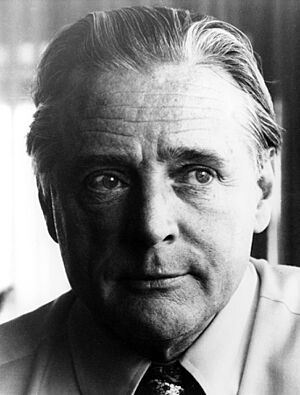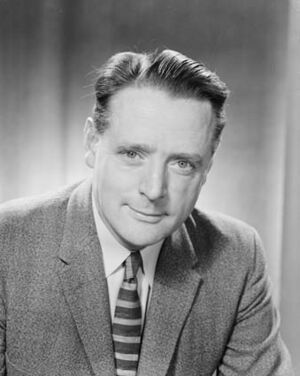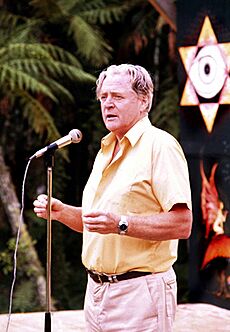Jim Cairns facts for kids
Quick facts for kids
Jim Cairns
|
|
|---|---|

Cairns in 1976
|
|
| Deputy Prime Minister of Australia | |
| In office 12 June 1974 – 2 July 1975 |
|
| Prime Minister | Gough Whitlam |
| Preceded by | Lance Barnard |
| Succeeded by | Frank Crean |
| Treasurer of Australia | |
| In office 11 December 1974 – 6 June 1975 |
|
| Prime Minister | Gough Whitlam |
| Preceded by | Frank Crean |
| Succeeded by | Bill Hayden |
| Minister for the Environment | |
| In office 6 June 1975 – 2 July 1975 |
|
| Prime Minister | Gough Whitlam |
| Preceded by | Moss Cass |
| Succeeded by | Gough Whitlam |
| Minister for Overseas Trade | |
| In office 19 December 1972 – 11 December 1974 |
|
| Prime Minister | Gough Whitlam |
| Preceded by | Gough Whitlam |
| Succeeded by | Frank Crean |
| Minister for Secondary Industry | |
| In office 19 December 1972 – 9 October 1973 |
|
| Prime Minister | Gough Whitlam |
| Preceded by | Gough Whitlam |
| Succeeded by | Kep Enderby |
| Deputy Leader of the Labor Party | |
| In office 12 June 1974 – 2 July 1975 |
|
| Leader | Gough Whitlam |
| Preceded by | Lance Barnard |
| Succeeded by | Frank Crean |
| Member of the Australian Parliament for Yarra |
|
| In office 10 December 1955 – 25 October 1969 |
|
| Preceded by | Stan Keon |
| Succeeded by | Division abolished |
| Member of the Australian Parliament for Lalor |
|
| In office 25 October 1969 – 10 November 1977 |
|
| Preceded by | Mervyn Lee |
| Succeeded by | Barry Jones |
| Personal details | |
| Born |
James Ford Cairns
4 October 1914 Carlton, Victoria, Australia |
| Died | 12 October 2003 (aged 89) Narre Warren East, Victoria, Australia |
| Political party | Australian Labor Party |
| Spouse | Gwen Robb |
| Alma mater | University of Melbourne |
| Occupation | Policeman, lecturer |
James Ford Cairns (born 4 October 1914 – died 12 October 2003) was an important Australian politician. He was a leader in the Labor Party during the 1960s and 1970s. He briefly served as Treasurer and Deputy Prime Minister under Prime Minister Gough Whitlam. Cairns is best known for leading the movement against Australia's involvement in the Vietnam War. He was also an economist and wrote many books about money and society.
Contents
Early Life and Education
James Ford Cairns was born in Carlton, a working-class area of Melbourne, Australia. His father was a clerk. Jim grew up on a dairy farm north of Sunbury. His father fought in World War I but became unhappy with the war. He did not return to Australia and later died in Africa.
Cairns went to Sunbury State School and then Northcote High School. Life was hard during the Great Depression, and his mother worked to support the family. Jim had to travel three hours by train every day to school. Despite this, he was a very good student. He even won the school's broad jump championship easily.
In 1933, Cairns joined the Police Force. He wanted more time for sports. He soon became a detective. While working, he studied at night and earned an economics degree from the University of Melbourne. He was the first police officer in Victoria to have a university degree. In 1939, he married Gwen Robb and adopted her two sons.
Cairns left the police force in 1944. He then worked as a tutor and lecturer for the Australian Army. Later, he became a senior lecturer in economic history at the University of Melbourne. He was very knowledgeable about economics and believed in socialism. In 1946, he tried to join the Communist Party but was not accepted.
After this, Cairns joined the Labor Party (ALP). He became active in the party's left wing. In 1955, when the Labor leader H. V. Evatt caused a big split in the party, Cairns supported Evatt. In the 1955 election, he ran for the House of Representatives in the area of Yarra. He won and held this seat until 1969. When the Yarra area was changed, he moved to the Lalor area in Melbourne. He easily won this seat too.
A Leading Left-Wing Politician
In Canberra, the capital city, Cairns became a leader of the left wing of politics. He was a very strong debater. Many ministers in the Liberal government, led by Robert Menzies, disliked him. However, Menzies himself respected Cairns because he was intelligent and had strong beliefs. Some people in his own Labor Party also disliked him. They thought his political ideas were too left-wing for Australian voters.
Despite this, Cairns' skills were clear. He earned his doctorate degree in economic history in 1957. By the 1960s, he was one of the Labor Party's most important figures. He also gave lectures on Marxist and socialist history. He taught free classes in Melbourne for working people who could not afford university. His first trip overseas to the US and Asia greatly influenced him.
In 1967, Arthur Calwell retired as Labor leader. Cairns ran for the leadership but lost to Gough Whitlam. The next year, when Whitlam briefly resigned, Cairns ran for leader again. He lost, but by a much smaller number of votes. Whitlam then made Cairns the shadow minister for trade and industry. Cairns, like other left-wing politicians of his time, strongly supported Whitlam. They knew Labor needed policies that appealed to the middle class to win power.
One main reason Cairns did not become leader was his focus on the movement against the Vietnam War. The Menzies government had sent troops to Vietnam in 1965. Cairns also opposed conscription, which was forcing young men to join the army. Until about 1968, most Australians supported the war. However, after 1968, more people began to oppose it. Cairns saw the anti-war movement as a very important cause.
In May 1970, Cairns led an estimated 100,000 people in a "sit-down" protest in the streets of Melbourne. This was part of the Vietnam Moratorium Campaign. It was the largest protest in Australia until 2003. Similar large protests happened in other Australian cities. There was no violence, and the peaceful protest had a big effect on how Australians viewed the war.
Cairns in Government
In the December 1972 election, Gough Whitlam led the Labor Party to victory. This was the first time Labor had been in government in 23 years. Cairns became the Minister for Overseas Trade and Minister for Secondary Industry. He had changed some of his socialist ideas but still strongly believed in government planning. He worked well with business leaders. During his time as minister, Cairns made many overseas trade visits. His trip to China was very successful. It led to a big increase in trade between Australia and China.
After the 1974 election, Cairns was elected Deputy Leader of the Labor Party. This made him the Deputy Prime Minister.
In December 1974, Whitlam appointed Cairns as Treasurer. This was a high point in Cairns' political career. On Christmas Day 1974, while Whitlam was overseas, Cyclone Tracy destroyed the city of Darwin. Cairns, as Acting Prime Minister, impressed the country with his caring and strong leadership during this disaster.
Australia's economic problems became worse in 1975. Cairns faced a new challenge called stagflation. This meant high unemployment and high inflation at the same time, which followed the 1973 oil crisis. Other countries faced similar problems, but many Australians did not know this. So, the Whitlam government's ability to handle the economy was questioned.
Loans Affair and Dismissal
In late 1974, the government wanted to borrow a lot of money from the Middle East for big projects. This plan became known as the "Loans Affair." Cairns learned about it shortly after becoming Treasurer. He signed an approval for the loan. However, his staff and other officials advised him that the person arranging the loan, Tirath Khemlani, might not be trustworthy.
As Acting Prime Minister, Cairns arranged a meeting where it was decided to cancel the authority to borrow the loan. However, when Whitlam returned, the authority was put back in place without Cairns' knowledge. Cairns later convinced Whitlam that the dealings should stop.
Cairns' political troubles grew from a separate issue. In 1974, he was introduced to George Harris, a businessman. Harris offered to help the government get loans. In March 1975, Cairns signed a letter agreeing to a commission for Harris. In June, Cairns made a statement to Parliament that was later found to be misleading about this commission. He said he had signed the letter without knowing what it was, among many other papers. Other politicians agreed that they sometimes signed letters without remembering them. However, because Cairns had signed the letter, Whitlam dismissed him from his ministerial roles on 2 July 1975.
Later Life and Legacy
In 1977, Cairns retired from Parliament. He then focused on the Counterculture movement. He helped organize "ConFests," which were large gatherings in rural areas. He was seen taking part in activities like meditation. In 1979, Cairns formally ended his connection with the main organizers of these events.
In his later years, he lived near Melbourne. He often sold his books outside local markets. There, he would talk to people about politics, history, and his life experiences.
In 1983, Cairns ran for the Senate as an independent candidate but was not successful. He remained a member of the Labor Party for most of his life, rejoining in 1996 after a brief period of lapsed membership.
In 2000, he was made a Life Member of the Labor Party. Jim Cairns passed away in October 2003 at the age of 89. He received a State Funeral.
Personal Life
Cairns married Gwen Robb in 1939. He adopted her two sons, Barry and Phillip. Cairns did not identify with any specific religion. He once said, "I have never believed myself to be anything that I can attach a name to. I was not a Christian. I did not regard myself as a humanist or a socialist. I was something: what I am, and it did not have a name."




